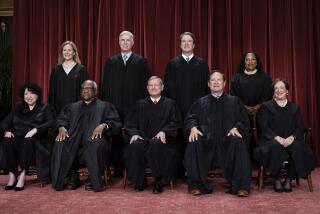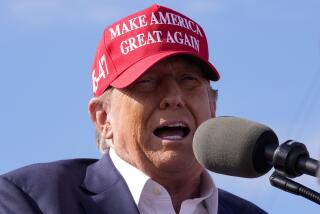White House Will Not Reveal Portion of Bush’s Political Travel Paid for by GOP : Reimbursement: The President logged tens of thousands of miles for 1990 party candidates. The costly trips often coincided with ‘official’ events.
- Share via
WASHINGTON — Amid the controversy surrounding travel by Chief of Staff John H. Sununu, the White House is refusing to release information about the extent of Republican Party reimbursements for President Bush’s extensive political travel last year.
Bush made more political appearances and raised more money for his party last year than any President in history. In the months before the 1990 election, the President logged tens of thousands of miles for GOP candidates, making 23 trips involving 65 personal appearances at campaign events.
While details about that travel have been kept tightly under wraps by the White House, the costs clearly are significant. Any presidential trip, for example, requires at least three airplanes: the modified Boeing 747 that serves as Air Force One, a backup plane and a military cargo carrier that leapfrogs ahead of Bush to carry one or more of his armor-plated limousines from city to city for his motorcades.
Under the law, Republican candidates and party committees are required to reimburse the government for the costs of operating Air Force One and other expenses when Bush makes political trips.
In many cases, Bush’s political trips were scheduled to coincide with other events--ranging from major speeches to Points of Light awards--that are deemed “official.” By mixing official and political travel, the White House may be able to charge much of the cost of such trips to the taxpayers.
Records on file with the Federal Election Commission show that the Republican National Committee paid $740,603 to the government for White House travel and communications in 1990. But RNC officials say they have no way of knowing how those bills are calculated or precisely what they are intended to cover. Decisions on how much to bill are “all done at the White House, the formula and everything,” said party spokesman Gary Koops.
White House officials consistently have refused requests from The Times and other news organizations to explain how the costs were calculated or which of Bush’s trips were considered “political” rather than “official” travel. “We don’t have anything to add or anything more to tell you,” Judy Smith, White House deputy press secretary, said Friday when asked about the subject.
Party officials have a clear incentive to take advantage of whatever leeway the law allows to shift costs to the government. A single Bush visit to California, for example, could entail bills of $50,000 to $100,000, said Rick Davis, former executive director of the California GOP and now a top aide to Sen. John Seymour (R-Calif.).
With price tags that high, some candidates--particularly congressional candidates in smaller states--sometimes shy away from the idea of a presidential visit for fear they would not be able to cover the full cost, said Tom Cole, executive director of the Republican Congressional Campaign Committee and former Oklahoma GOP chairman.
White House spokesman Marlin Fitzwater insisted that the Administration has made no attempt to shift costs from the party to taxpayers. “It’s all done according to the formula,” he said. White House officials, however, refuse to say what that formula is or how it is applied.
An example of the mix of political and nonpolitical travel is a trip that Bush took last year. On the evening of Friday, May 18, Bush spoke at a fund-raising dinner for the Texas GOP in Dallas, a political event. After the speech, he flew to Houston for an “official” event, a brief tour of the site to be used a few months later for the international economic summit.
The next morning, Bush flew to Austin for a commencement speech at the University of Texas, then flew to Portland, Ore., for a brief visit that combined an “official” dedication of a memorial to slain police officers with a political fund-raising breakfast for Oregon’s Republican candidate for governor, David Frohnmayer.
Following that trip, Bush flew to Los Angeles, where he briefly attended a ceremony to award a Point of Light to the Oakwood Community anti-crime program. But before leaving the city, he drove to Bel-Air to a $25,000-per-head fund-raiser at the home of David Murdock, the head of Castle Entertainment. That event, party officials said, raised some $700,000 for the GOP.
All told, Bush raised some $2 million at various events on that trip, party officials said. How much, if any, of the cost of the trip was charged to the GOP is unclear. The RNC’s filings with the Federal Election Commission do not show any substantial payments to the government for White House travel during May or June of 1990, although the cost of the trip could have been included in lump-sum payments made later in the year.
The RNC’s filings show that for the full year, the party paid $141,771 to the Treasury for Air Force One, $215,712 to the White House Communications Agency, $217,210 to the “airlift operations office” and $165,910 to other White House agencies for costs associated with Bush travel.
The party, in turn, billed GOP candidates for the House and Senate a total of $357,500 to cover a portion of those costs, according to FEC records reviewed by The Times. State parties and candidates for state office, who are not required to file disclosure statements with the FEC, may have contributed additional sums to cover the party’s costs. California Gov. Pete Wilson’s campaign committee, for example, reported having paid the RNC $27,000 for unspecified “travel” costs during the last quarter of 1990.
Although those sums are substantial, so are the costs they are meant to cover. In addition to the cost of operating Air Force One, party officials are expected to pay for the expenses of the White House advance team that sets up the site for presidential events, the cost of food and lodging for Bush and other officials involved in political events, and additional costs for communications and other expenses of the trip. Air Force officials so far have declined to reveal the operating costs for Air Force One.
Researcher Stephanie Grace in Washington and staff writer Daniel Weintraub in Sacramento contributed to this report.
More to Read
Get the L.A. Times Politics newsletter
Deeply reported insights into legislation, politics and policy from Sacramento, Washington and beyond. In your inbox twice per week.
You may occasionally receive promotional content from the Los Angeles Times.











